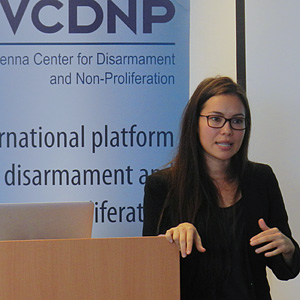

In 2014, the VCDNP won the European Space Imaging (EUSI) & Skybox Imaging High-Res Challenge as part of the 2014 Copernicus Masters Competition. The Copernicus Masters Competition awards prizes for innovative solutions for business and society based on Earth observation (EO) data. The goal of the winning project, submitted by Tamara Patton, VCDNP Research Associate and PhD Candidate at Princeton University, was to provide a snapshot of how emerging types of EO capabilities, such as agile constellations of small satellites, high definition (HD) video and new regional systems, could support non-proliferation and disarmament verification needs. Patton discussed the results of the winning project at a VCDNP seminar held on 30 October 2015.

The project brings together an international community of experts from academia, non-governmental organizations and industry, to identify future possibilities for research, development and engagement in non-proliferation and disarmament verification. In looking at new agile constellations of small satellites being created by companies like Skybox and Planet Labs, there are many benefits to using these technologies for verification purposes. The smaller satellites are more affordable and can be deployed into space at lower cost. Given the lower cost of deployments, these smaller satellites can be launched into space on a larger scale, allowing for more frequent rapid revisit rates and a greater collection of images. This allows researchers and organizations to task a satellite to capture images of a specific site more easily and without having to consider the larger costs normally associated with tasking a satellite.
Although these satellites are less expensive to deploy, there is often a tradeoff in the resolution quality of the images. In order to overcome this tradeoff, it is best to combine the less expensive satellite images with frequent revisit rates captured by satellites such as Skybox, with more precise and high-resolution images such as those taken by the WorldView-3 satellite. The Skybox imagery allows one to acquire an overall understanding of a site due to its frequent revisit rate capability and identify objects of interest. Combined with a more precise and high-resolution image, such as one provided by the WorldView-3 satellite, it is possible to focus on specific objects and conduct a more detailed exercise with the images.
HD video capability allows one to have an even larger set of imagery (approximately 2700 images at once). Though the cost for these videos is rather high, the benefit comes from creating 3-dimensional (3D) reconstructions of test sites. For example, by fusing satellite imagery with HD video, researchers can create 3D models of test sites or get a better idea of the sites enrichment capacity capability and identify where such operations are taking place on a given site. HD video capability can also be very useful for inspection purposes.
The project also took into consideration data provenance, a non-traditional approach to imagery and metadata formatting and distribution. An important aspect of data provenance is how researchers and organizations can ensure that an image has not been doctored and that the images were collected at the time and place indicated. This is extremely important in the context of treaty verification and will need to be further developed, for example through the creation of international standards. However, it is not a deal-breaker for the use of these emerging technologies for verification purposes, as long as the images processing steps can be retraced back to the point where the data was provided.
The Copernicus project worked with a number of these new EO data capabilities and tested their usefulness for the non-proliferation and disarmament verification community by using the Democratic People’s Republic of North Korea (DPRK) as a case study. The study analyzed two nuclear sites: Yongbyon, including both the enrichment center and reactors, and the Punggye-ri nuclear test site. The case study was launched on a web portal that allows invited experts to engage with the images by commenting on them to identify key components of the images and analyze activities at the various sites. The interactive aspect of the online portal is currently ongoing and the final results will be published in a report to be released in December 2015.
The project is useful in bringing together the non-proliferation and disarmament verification community with these new companies designing EO capabilities to flag issues that will help make data evaluation possible, especially for verification purposes. Since the companies looking into small satellites are building large data archives that will cover the globe, it should become easier for international verification organizations to fill in data gaps, such as what activities have taken place prior to a nuclear test. A satellite imagery archive can assist researchers and officials in conducting before and after comparisons of a test site without having to have targeted a certain location prior to the actual test or suspected event. The smaller constellations make it more affordable to look at different test sites at various stages and can assist the verification regime in conducting a more comprehensive analysis.